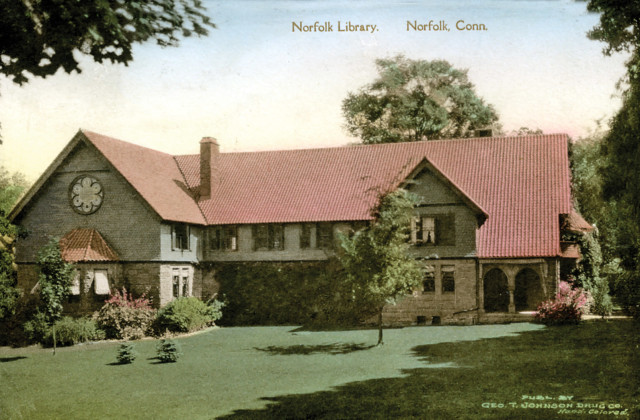Library Receives $200,000 Grant to Restore Tile Roof
Capital Campaign to Raise Additional Funds Starts February 1
By Ruth Melville
Wednesday, January 7, was a red-letter day in the history of the Norfolk Library. At 4:15 p.m., the library’s board of trustees received the good news they were hoping for, their application for a $200,000 grant from the state to help restore the library’s original red tile roof was successful.
This grant from the Historic Restoration Fund Grant Program of the State Historic Preservation Office (SHPO) will enable the library to remove the deteriorating asphalt roof and replace it with the original red tiles, reinstating the crowning glory of George Keller’s architectural masterwork. Restoring the roof will be the first, and most visible, step in a three-phase, multiyear project to renovate this historic piece of town architecture.
The trustees were so committed to this project that they voted to go ahead with it before they knew the status of the grant request. For Robert Dance, president of the board, the importance of receiving the grant is “not even so much the funding itself as the endorsement” of the importance of preserving the architectural integrity of the original design.
The application process was a long and demanding one. A crucial first step, even before an application could be submitted, was a site visit by Laura Mancuso, the SHPO’s construction grants manager. Library Director Ann Havemeyer had a good feeling after Mancuso’s visit. She was “dynamic” and “gave off positive vibrations,” but, “You never know what the competition is going to be.”
The application eventually filled a one-and-a-half-inch ring binder. The library had to provide copies of their financial records, budget statements, construction schedules and site maps, a certificate of endorsement from the Norfolk Historic District Commission, photographic documentation of the original and current state of the building (the current ones were taken by Chris Little with his drone camera), statements on the library’s human rights and diversity practices and letters of support from members of the community.
To qualify for a grant, a building has to be on the National Register of Historic Places, and the restoration has to provide economic and social benefit to the community. Regional impact and high visibility are important, so the library’s prominent location on Route 44 worked in its favor.
But having a worthy project is not enough. In judging applications, the SHPO places a lot of weight on the grantee’s demonstration of the ability to raise the remaining money and complete the project on schedule. Dance is sure that one reason their application was successful was because of the library’s sound financial state. “Even though fund raising is still in its quiet phase,” Dance adds, the board “expected and has gotten a strong response from the public.”
A stipulation of the grant is that it cover only half the costs of the project. Restoring the roof, as well as repairing chimneys, flashings and gutters, is projected to cost $468,000. In effect, the $200,000, which is the maximum for this particular grant, will cover the cost of all the roof materials.
The library’s capital campaign to raise the rest of the money officially begins on February 1. The library has not asked for major donations since the children’s wing was added in the 1980s. Trustee John Garrels says, “The last generation’s project was the children’s wing. This is our generation’s project.”
Construction on the roof is due to begin on April 1, and should be completed by November 1. Phase two of the planned restoration is to repair and clean the masonry walls, while phase three will tackle the landscaping and drainage around the building. Next October, the library will apply for a second grant to complete the last two phases, which are scheduled for the 2016 construction season. The total cost of the entire project, including the roof restoration, is $875,000.
Havemeyer is eager for the work to begin. Once the red tile roof is back, she says, “It will be a showstopper.” She points out that the Music Shed and Great Mountain Forest have also received grants from the SHPO, signs of recognition of the history and architectural heritage of Norfolk and the Northwest Corner.
The firm of John G. Waite Associates, which did a complete assessment of the building as part of the application process, will oversee the work. Waite Associates specializes in historical restoration, and its notable projects include work at the University of Virginia, the Franklin D. Roosevelt Library at Hyde Park and The Mount in Lenox, which received a National Trust for Historic Preservation Award.
Official credit for the library’s grant goes to the SHPO of the Department of Economic and Community Development through Connecticut’s Historic Restoration Fund and the Community Investment Act of the State of Connecticut.
Copies of a brochure outlining the restoration project are available in the Norfolk Library and Town Hall.
Postcard courtesy of Norfolk Historical Society.

